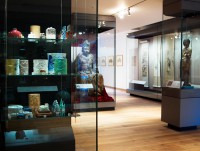Room 38 | China from AD 800 gallery
Explore key developments in the history and culture of China, from the arts and crafts of the Song Dynasty up to the present day.

The highest quality white porcelain in southern China was made at Jingdezhen in Jiangxi province. From the late 1300s to around 1915 it was the site of the imperial kilns. Kilns on the east coast also produced fine wares. Greenwares from Longquan were exported to Korea, Japan and the Middle East, also the destination for most early blue-and-white porcelain. Porcelain with blue decoration painted beneath the glaze only became widespread within China after AD 1400. By around 1430 enamels were applied over the glaze, and porcelain became highly decorated with colourful patterns.
 Blue-and-white dish with floral decoration (LI1301.144)
Blue-and-white dish with floral decoration (LI1301.144)
 Blue-and-white dish with a kylin, or horned creature (EAX.1707)
Blue-and-white dish with a kylin, or horned creature (EAX.1707)
 Greenware dish with fish (EAX.1271)
Greenware dish with fish (EAX.1271)
 Blue-and-white stem cup with a dragon and clouds (EA2007.263)
Blue-and-white stem cup with a dragon and clouds (EA2007.263)
 Octagonal stem cup with flower (EA1956.1143)
Octagonal stem cup with flower (EA1956.1143)
 Blue-and-white stem cup with a dragon and flower (EAX.1387)
Blue-and-white stem cup with a dragon and flower (EAX.1387)
 Blue-and-white moon flask or bianhu (EA1997.190)
Blue-and-white moon flask or bianhu (EA1997.190)
 Porcelain saucer dish with flowers (EAX.1699)
Porcelain saucer dish with flowers (EAX.1699)
 Vase with floral decoration (EA1969.76)
Vase with floral decoration (EA1969.76)
 White ware vase with floral decoration (EA1956.1399)
White ware vase with floral decoration (EA1956.1399)
 Greenware vase with floral decoration (EA1956.3918)
Greenware vase with floral decoration (EA1956.3918)
 Greenware vase in double-gourd form (EA2008.30)
Greenware vase in double-gourd form (EA2008.30)
 Blue-and-white stem bowl with lotus flowers and mandarin ducks (EAX.1386)
Blue-and-white stem bowl with lotus flowers and mandarin ducks (EAX.1386)
 Blue-and-white meiping, or plum blossom, vase (EAX.1398)
Blue-and-white meiping, or plum blossom, vase (EAX.1398)
 Dish with floral decoration (EA1978.407)
Dish with floral decoration (EA1978.407)
 White ware bowl with fluted decoration (EA1956.1436)
White ware bowl with fluted decoration (EA1956.1436)
 White ware dish with floral decoration (EA1956.3147)
White ware dish with floral decoration (EA1956.3147)
 Dish with dragon (EAX.1190)
Dish with dragon (EAX.1190)
Reign mark of the Emperor Xuande (ruled 1426-1435)
Reign marks state the names of the dynasty and the emperor in power at the time the porcelain was made. The earliest is that of the Ming emperor Yongle (ruled 1401-1425). The reigns of Xuande (ruled 1425-1435) and Chenghua (ruled 1465-1487) are regarded as the finest periods for Ming porcelain, and their marks often appear on later wares.
Humay and Humayun in the Jasmine Garden
From the manuscript of a narrative poem by Khvaju Kermani, date 1396. The vase in the centre of this Persian manuscript painting is the earliest depiction of Chinese blue-and-white porcelain. The poem tells of Prince Humay’s quest to China to find the princess, Humayun, with whom he has fallen in love.
Jingdezhen dish exported to Korea
In 1976 two fishermen discovered a shipwreck dating from the 1320s off the Korean coast. It contained a cargo of more than 2000 Song and Yuan dynasty ceramics, bronzes and other goods. An identical piece to this one was found on board. An early 20th-century label on the base of this dish says it also was found in Korea.
Notice
Objects may have since been removed or replaced from a gallery. Click into an individual object record to confirm whether or not an object is currently on display. Our object location data is usually updated on a monthly basis, so contact the Jameel Study Centre if you are planning to visit the museum to see a particular Eastern Art object.
© 2013 University of Oxford - Ashmolean Museum




